If the words Panda Express chow mein send you straight back to the mall food-court – steam wafting, soy-savory aromas trailing the neon-lit counter – this copycat recipe is for you. But instead of waiting in the queue for a cardboard box slick with grease, you can recreate that same satisfyingly springy noodle dish at home in under 25 minutes.
Why bother? First, you control everything: oil level, sodium, noodle texture, even the crunch-to-noodle ratio of cabbage and celery. That means a lighter, cleaner bowl that still nails the signature sweet-savory sauce and kiss of wok char. Second, it’s weeknight-friendly. Busy, flavor-obsessed cooks can keep the sauce pre-mixed in a jar, stash noodles in the pantry, and have dinner on the table faster than a delivery driver could find parking. Finally, there’s the cost factor – one family-size batch costs less than two individual Panda sides and leaves zero soggy leftovers.
So grab your skillet (or wok if you’ve got one) and channel that nostalgic mall vibe, minus the price markup, the mystery oils, and the extra wait. Your own kitchen is about to become the most reliable “Panda Express” in town.
Why You’ll Love This Chow Mein Recipe
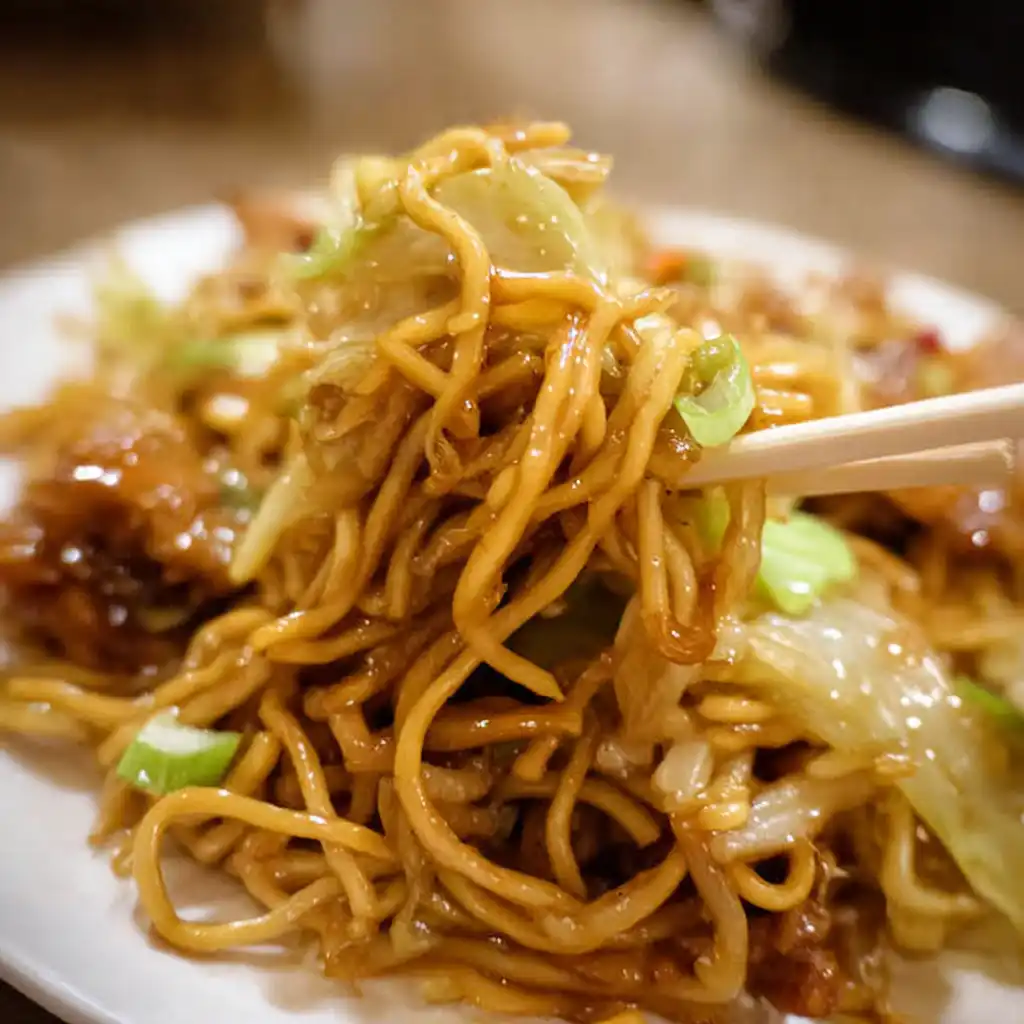
- Quick & Easy: Ready in under 25 minutes with minimal prep, perfect for busy weeknights.
- Simple Ingredients: No hard-to-find items; everything’s available at your local grocery store.
- Comfort in a Bowl: Delivers that nostalgic Panda Express flavor without the greasy after-feel.
- Unbelievably Delicious: A perfect balance of savory, slightly sweet, and umami-rich sauce clings to every noodle.
- Crowd-Pleaser: Great for family dinners or casual gatherings, everyone goes back for seconds.
- Better Than Takeout: Toasted noodles, crisp veggies, and a richer, cleaner flavor set this apart from other copycats.
- Impress Without Stress: Guests will think you ordered out, until they see you flip noodles like a pro.
Ingredients You’ll Need to perfect this Panda Express Chow Mein Recipe
This simple chow mein delivers bold flavor with pantry-friendly ingredients. Here’s what to gather:
For the Noodles & Veggie Base
- 2 packs of dry Yakisoba noodles (discard seasoning packets; cook and drain beforehand)
- 3 tablespoons neutral oil (like canola or avocado oil, for that essential stir-fry sizzle)
- ½ medium yellow onion, thinly sliced (adds subtle sweetness and depth)
- 8 oz green cabbage, finely shredded (for crunch and balance)
- 2 oz celery stalks, chopped into bite-sized pieces (classic Panda texture)
For the Signature Sauce
- 1½ tablespoons soy sauce (regular or low-sodium – your call on saltiness)
- 1 tablespoon oyster sauce (adds rich umami body; use mushroom version for vegan)
Optional Enhancements:
- A pinch of white pepper for a subtle heat kick
- A dash of sesame oil for a nutty finish
- Green onions or bean sprouts, tossed in at the end for extra freshness and texture
How to Make Perfect Panda Express Chow Mein (Step-by-Step)
Loosen the noodles.
If using packaged yakisoba noodles, discard the seasoning packets. Briefly rinse the noodles under warm water to separate them, then drain thoroughly. This prevents clumping later.
Heat your pan.
Add 3 tablespoons of oil to a large wok or skillet and set it over high heat. Let the oil get hot, just to the point where it shimmers. This helps mimic the high-heat “wok hei” flavor from restaurants.
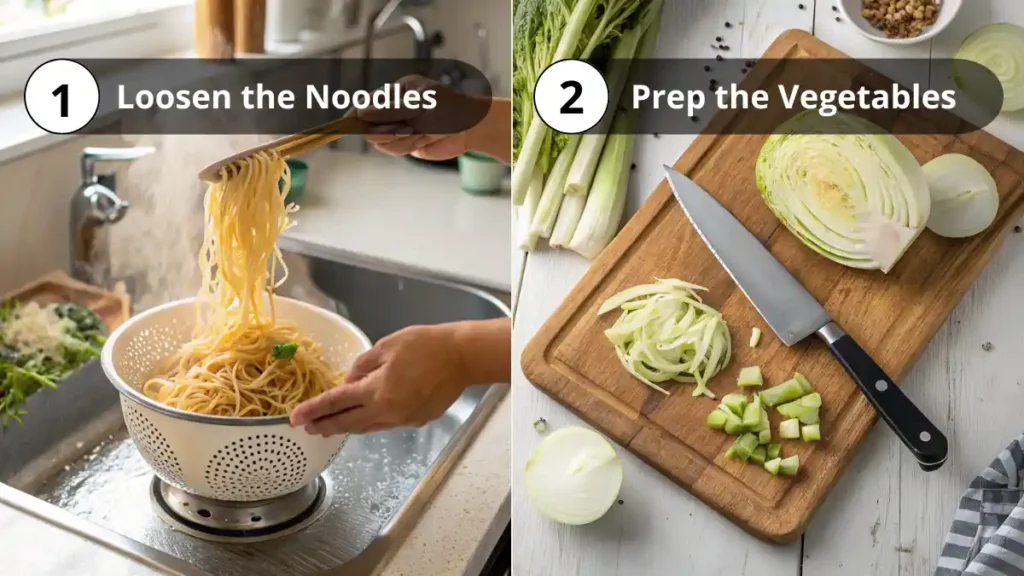
Sear the veggies.
Toss in the sliced onion, cabbage, and celery. Let them sit undisturbed for 2–3 minutes so they develop slight caramelization. This step deepens the flavor and adds sweetness.
Stir-fry to finish the veg.
Stir the vegetables and cook for another 2 minutes, until the edges are golden and the cabbage softens slightly but still has some bite.
Add noodles and toss.
Add the pre-cooked noodles to the pan. Use tongs to gently mix them with the vegetables. Don’t force it, let the heat do the work to separate and warm them.
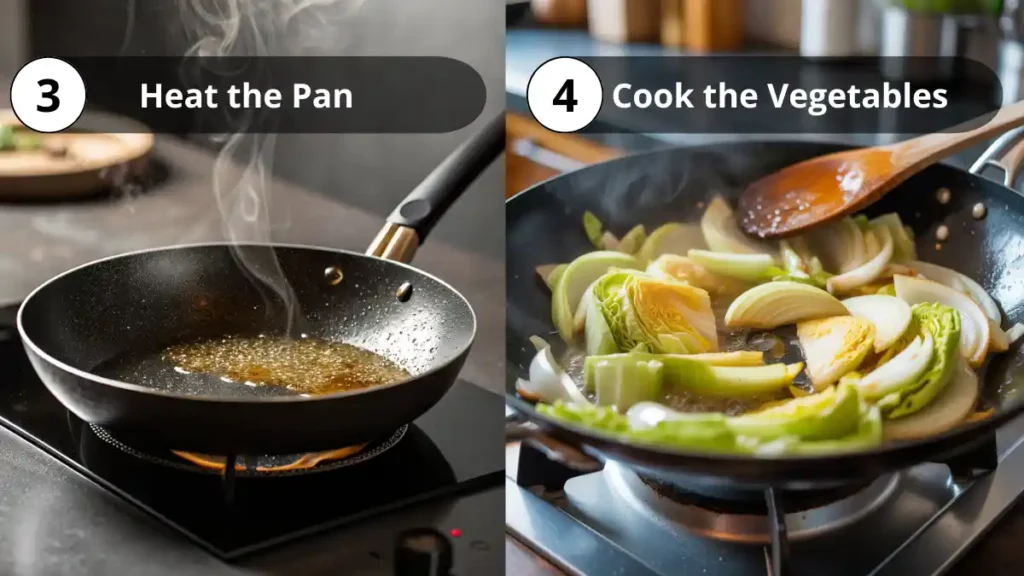
Incorporate the sauce.
Pour in 1½ tablespoons soy sauce and 1 tablespoon oyster sauce directly over the noodles. Toss well until everything is evenly coated and heated through. Look for the noodles to turn glossy and slightly golden in spots.
Taste and adjust.
Give it a quick taste. If needed, add a splash more soy sauce or a dash of sesame oil for extra depth. Serve immediately while hot and fragrant.
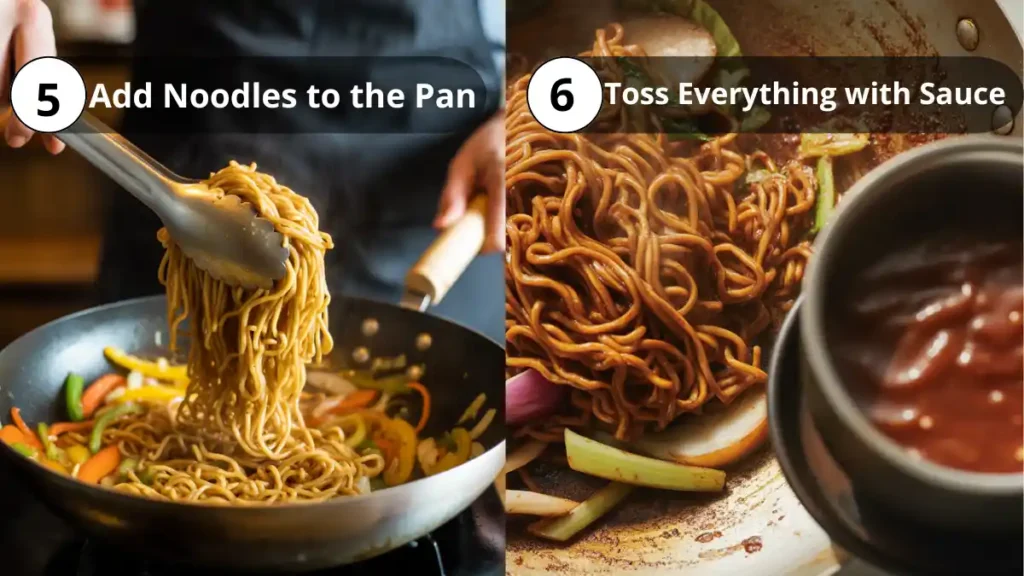
Tip: Want that restaurant-style edge? Use a carbon steel wok or cast-iron pan for maximum heat retention and char.
Tips & Tricks for Perfect Panda Express Chow Mein Recipe at home
Mastering great chow mein at home isn’t just about ingredients – it’s about how you treat the heat, texture, and timing. Use these pro-level tips to elevate your dish from good to unforgettable.
Achieving Wok Hei at Home
That deep, smoky “breath of the wok” flavor – known as wok hei – is what separates okay chow mein from restaurant magic.
- Use a carbon steel wok or cast-iron skillet. These retain high heat and encourage charring.
- Preheat your pan for 2–3 minutes before adding oil. You should see a light shimmer or slight wisp of smoke – that’s your green light.
- Avoid overcrowding. If needed, cook in batches to keep the temperature high and prevent steaming.
- Toss, don’t stir. Quick, upward movements expose food to intense heat and allow some caramelization.
Other Expert Tips
- Don’t overcook the noodles. Slightly underdone noodles will finish cooking in the pan and avoid turning mushy.
- Let the veggies sit before stirring. A little patience gives you the golden edges that boost flavor.
- Make the sauce in advance. Premixing saves time and ensures even coating when things move fast in the pan.
- Upgrade with sesame oil. A few drops at the end adds nutty aroma and authenticity.
- Store it right. Leftovers keep well for 2–3 days in the fridge – but skip the microwave and reheat in a hot pan for best texture.
Substitutions & Variations
This Panda Express Chow Mein Recipe is endlessly adaptable. Whether you’re working around dietary restrictions or just want to change things up, here are easy ways to customize it:
Vegan-Friendly Option
- Replace oyster sauce with mushroom-based oyster sauce or hoisin for a similar umami kick.
- Add in sautéed shiitake mushrooms or tofu strips for extra depth and protein.
- Finish with a splash of vegetarian stir-fry sauce or a pinch of sugar to balance the savory edge.
Gluten-Free Version
- Use tamari or gluten-free soy sauce in place of regular soy sauce.
- Swap in rice noodles or gluten-free yakisoba (some Asian markets carry these) for the wheat-based noodles.
- Double-check your oyster sauce – some brands offer certified gluten-free versions.
High-Protein Chicken Edition
- Slice boneless chicken thighs or breast thinly and marinate in a mix of soy sauce, cornstarch, and a splash of Shaoxing wine.
- Stir-fry the chicken first until just cooked through, remove, and then proceed with the veggies and noodles.
- Add the chicken back in at the end to coat with sauce and finish heating.
Other Ideas:
- Toss in snap peas, carrots, or bean sprouts for color and crunch.
- Craving spice? Add a drizzle of chili oil or sriracha just before serving.
- Want a heartier meal? Serve alongside egg rolls, potstickers, or a bowl of egg drop soup.
Want a complete takeout-style dinner? Pair this chow mein with our savory Black Pepper Chicken or the sweet-and-spicy kick of SweetFire Chicken Breast
Troubleshooting – Solving Common Chow Mein Problems
Even a simple dish like Panda Express Chow Mein Recipe can go sideways if you’re not careful. Here’s how to fix (or prevent) the most common issues that home cooks face:
Q: Why are my noodles soggy or clumping together?
A: This usually means the noodles were overcooked or not drained properly.
Fix it:
- Rinse cooked noodles under cold water and drain thoroughly.
- If they’re clumped, gently separate them with a bit of oil before adding to the pan.
- Next time, slightly undercook the noodles—they’ll finish in the wok.
Q: My chow mein tastes bland. What went wrong?
A: You may not have used enough sauce, or your pan wasn’t hot enough to bring out the flavors.
Fix it:
- Adjust with an extra splash of soy sauce or a pinch of sugar to round things out.
- Add a dash of sesame oil or white pepper for more depth.
- Taste the final dish before serving and season accordingly.
Q: There’s no char or “wok flavor” like takeout. What’s missing?
A: You’re likely not using enough heat or overcrowding the pan.
Fix it:
- Preheat your pan until it’s hot enough to sizzle immediately.
- Cook in smaller batches if necessary to avoid steaming.
- Let ingredients sit briefly before tossing, this helps build caramelization.
Q: My vegetables turned mushy. How do I keep the crunch?
A: Overcooking is the culprit.
Fix it:
- Stir-fry over high heat and don’t walk away.
- Add veggies like cabbage and celery last, and cook just until slightly tender with a crisp bite.
Q: The noodles absorbed all the sauce, what can I do?
A: That’s normal with hot noodles, but a dry texture can feel off.
Fix it:
- Reserve a tablespoon or two of the sauce to drizzle just before serving.
- Toss quickly once added to avoid over-absorption.
Keep this section handy, next time your chow mein doesn’t turn out just right, these quick fixes will get you back on track.
The Real Story Behind American-Style Chow Mein
Did you know?
What we call “chow mein” in fast-food chains like Panda Express isn’t traditional at all.The original Cantonese version was dry-fried and crisp, often using very little sauce. But when Chinese immigrants adapted their cuisine for American diners in the early 20th century, the dish gradually evolved. By the 1980s, takeout-style chow mein had become softer, sweeter, and saucier to suit American palates.
Panda Express helped standardize this version, adding cabbage and celery, swapping out traditional ingredients like Shaoxing wine, and introducing a soy-based sauce blend for mass appeal.
Making it at home doesn’t reject that history, it lets you reimagine it, with balance and control.
Frequently Asked Questions (FAQs)
The classic Panda Express chow mein features stir-fried wheat noodles, cabbage, celery, and onions, all tossed in a savory soy and oyster sauce blend. This copycat version captures that exact flavor profile, with fewer additives and less oil.
Yes! Yakisoba noodles are a perfect substitute and are often used in copycat recipes. Just be sure to discard the seasoning packet and rinse the noodles before using to prevent clumping.
While delicious, the original version is relatively high in sodium, oil, and calories. This homemade version cuts the oil in half and lets you control every ingredient, making it a cleaner, lighter alternative.
Chow mein sauce typically includes soy sauce, oyster sauce, and sometimes a bit of sugar, sesame oil, or white pepper. It’s a simple combination that delivers bold, savory flavor.
No, the traditional Panda Express chow mein contains oyster sauce, which is not vegan. However, this recipe can be easily adapted with mushroom oyster sauce for a fully plant-based version.
Nutrition Information
Here’s how this homemade version stacks up against the original side from Panda Express. Keep in mind, this recipe serves 4 and uses half the oil and no added MSG or preservatives.
| Nutrient | Homemade (Per Serving) | Panda Express (Per Serving) |
|---|---|---|
| Calories | ~290 | 510 |
| Total Fat | 10g | 22g |
| Saturated Fat | 1.5g | 3.5g |
| Sodium | 780mg | 980mg |
| Total Carbohydrates | 38g | 80g |
| Sugars | 4g | 9g |
| Protein | 6g | 13g |
| Fiber | 3g | 4g |
According to Panda Express’s official nutrition information, one 11 oz serving of their chow mein contains 600 calories, 23 g total fat, 94 g carbs, and 1000 mg sodium. Our homemade version delivers comparable flavor at just ~290 calories, half the fat and sodium, and fewer carbs, making it a cleaner, better-for-you choice.
Note: Actual values may vary depending on exact brands and ingredient quantities used. Homemade nutrition calculated using standard pantry ingredients and low-sodium soy sauce.
Curious how this stacks up with other dishes? Check out the nutrition breakdown of Chicken Fried Rice or explore whether Chicken Fried Rice is actually healthy.”

Better-Than-Takeout Panda Express Chow Mein (Easy Copycat Recipe)
Ingredients
Equipment
Method
- Prepare veggies. Slice the onion and cabbage thin; cut celery into angled pieces. Set aside.
- Soften noodles. Rinse cooked yakisoba under warm water to loosen, then drain well.
- Heat your pan. Add oil to a large skillet or wok. Heat on high until shimmering.
- Sear the vegetables. Add onions, cabbage, and celery. Cook without stirring for 2–3 minutes until lightly browned.
- Toss and finish veg. Stir to finish cooking for another 2 minutes. Cabbage should wilt but retain some crunch.
- Add noodles. Toss noodles into the pan with veggies using tongs; separate gently if clumped.
- Sauce it up. Pour in soy and oyster sauces. Stir until noodles are evenly coated and glossy.
- Finish & taste. Add sesame oil, sugar, or white pepper to taste. Serve hot.
- Pro Tip: Don’t stir too early – allow veggies to char slightly to mimic the takeout “wok hei” flavor.
Notes
Nutrition Information (Estimated per Serving)
SERVING: 1 bowl | CALORIES: 290 kcal | CARBOHYDRATES: 38 g | PROTEIN: 6 g | FAT: 10 g | SATURATED FAT: 1.5 g | CHOLESTEROL: 0 mg | SODIUM: 780 mg | POTASSIUM: 240 mg | FIBER: 3 g | SUGAR: 4 g | VITAMIN A: 480 IU | VITAMIN C: 4 mg | CALCIUM: 60 mg | IRON: 1.1 mgPrice of Recipe (Estimates in USD)
Total cost: ~$7.50 for 4 servings- Yakisoba noodles (2 packs): $2.50
- Fresh produce (onion, cabbage, celery): $2.00
- Sauces & oil (per portion): ~$3.00
Recipe Notes
- Substitutions:
- Use rice noodles for gluten-free, or ramen if you’re out of yakisoba.
- Oyster sauce → hoisin (sweeter) or mushroom oyster sauce (vegan)
- Storage & Reheating:
- Keeps well refrigerated for up to 3 days.
- Reheat in a hot pan – not the microwave – for best texture.
- Variations:
- Add cooked chicken, tofu, or shrimp for protein.
- Want it spicy? Stir in chili crisp or sriracha at the end.
- Add snap peas or bean sprouts for extra crunch.
Call-to-Action (CTA)
Did you love this affordable recipe?Share it with your friends, drop your rating below, and let us know in the comments how you made it your own. Craving more takeout classics? Stay tuned for our deep-dive on Lo Mein vs Chow Mein coming next!
Conclusion & Call to Action
Now that you’ve nailed this homemade Panda Express chow mein, you’ve officially leveled up your takeout game, without ever leaving the kitchen. This recipe brings all the comfort and bold flavor of the original, but lighter, fresher, and fully under your control.
If you gave it a try, I’d love to hear from you!
Leave a rating below, drop a comment with your tweaks or tips, and share this recipe with someone who always orders chow mein.
Hungry for more takeout-style recipes that actually deliver?
Stay tuned for the upcoming “Lo Mein vs Chow Mein Deep-Dive” where we’ll compare sauces, textures, noodles, and techniques to settle the stir-fry showdown once and for all.
Follow us and join the flavor crew on [Instagram ], [Pinterest], and [ Facebook] for daily kitchen wins, sneak peeks at upcoming dishes, and exclusive behind-the-wok content.
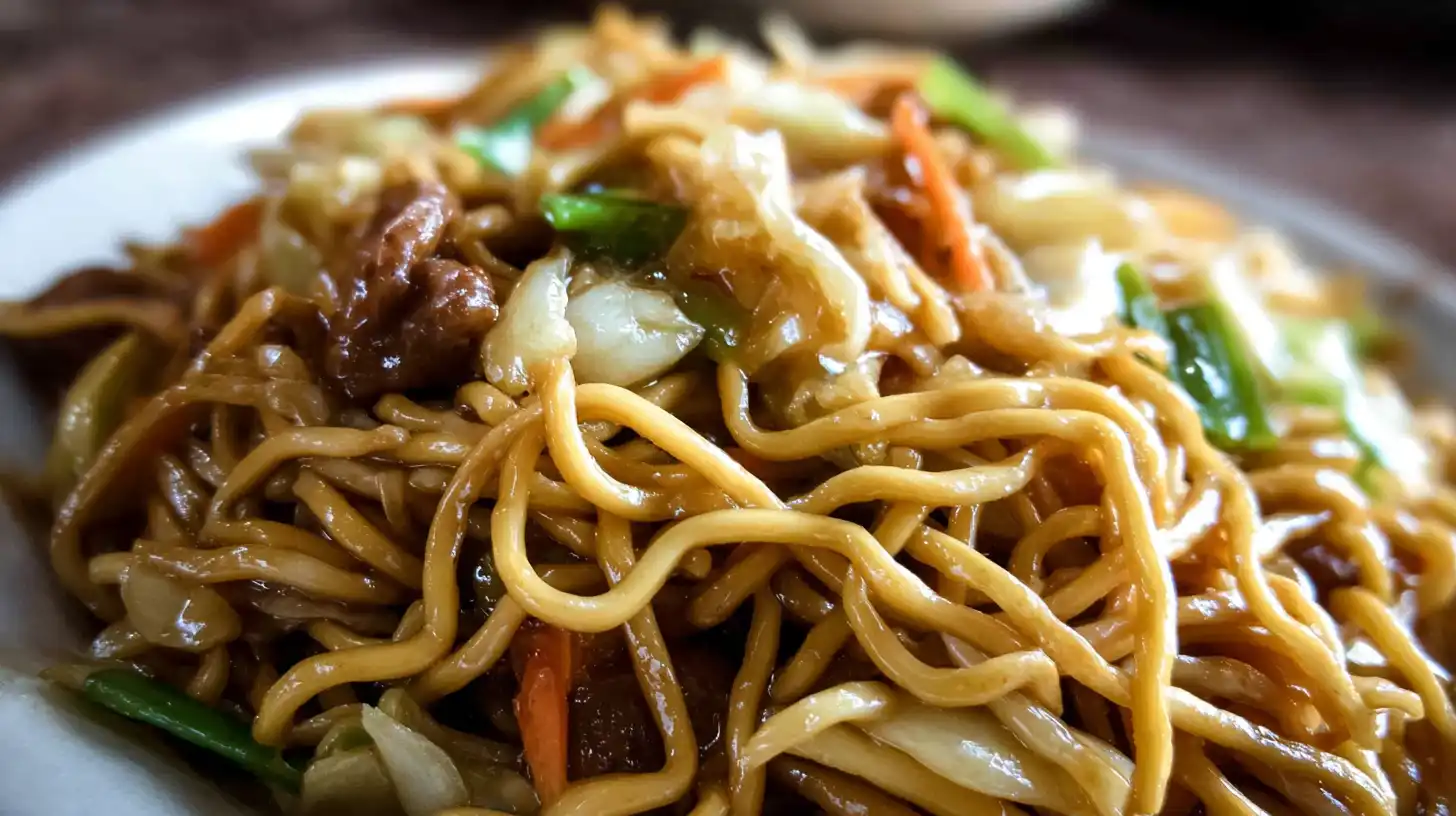

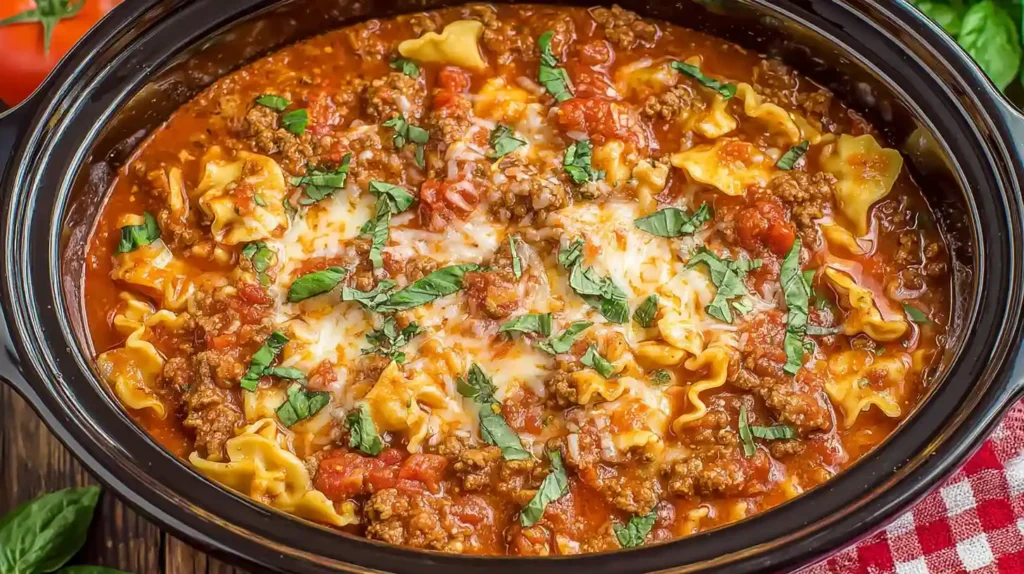
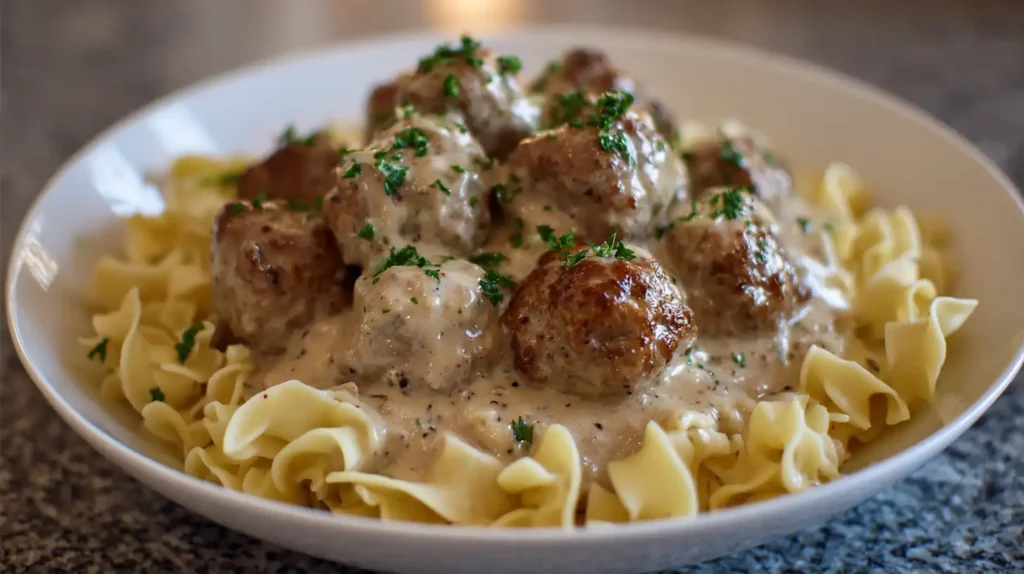

1 thought on “The Perfect Panda Express Chow Mein Recipe (Copycat)”